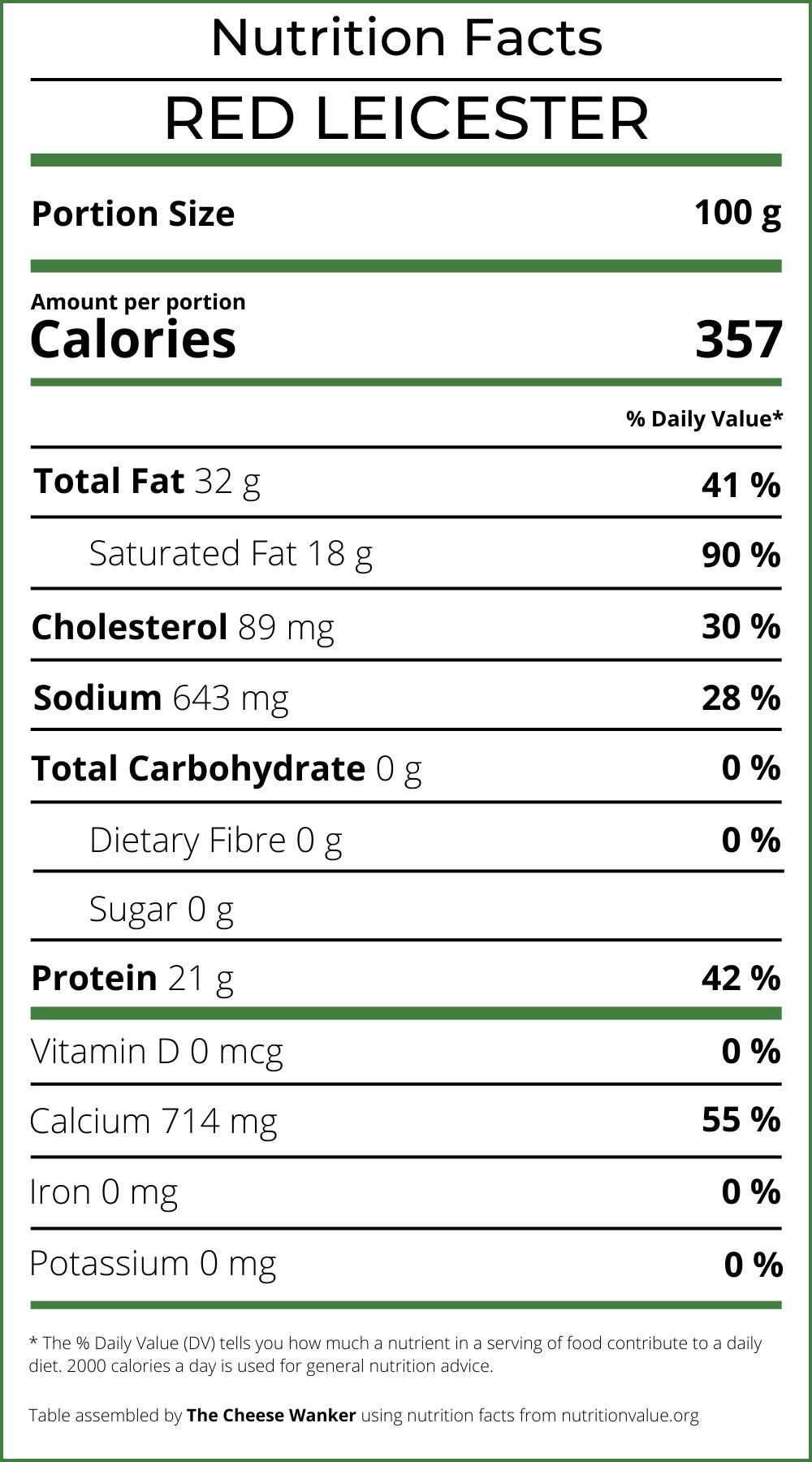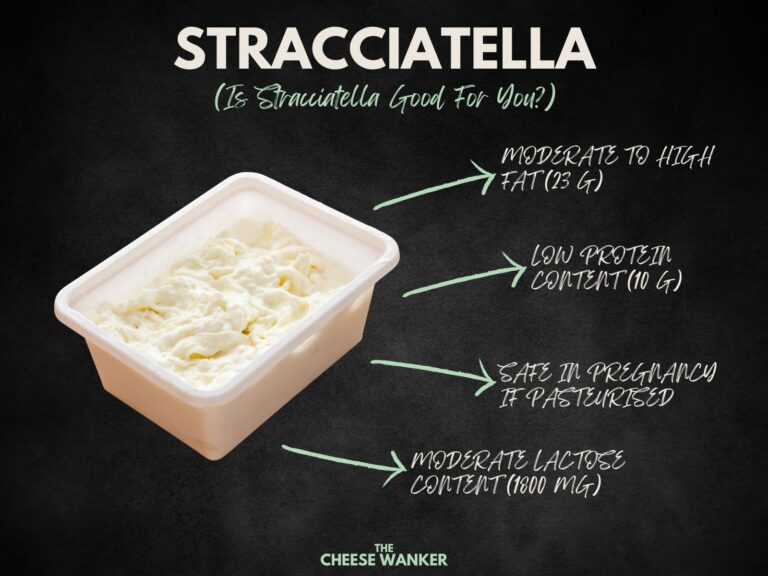Red Leicester, with its vibrant orange hue and rich heritage, stands as a celebrated delight in the world of cheeses. Originating in England, this dairy gem boasts distinctive organoleptic properties that captivate the senses. As we delve into the nutrition facts for Red Leicester, we unravel the fascinating tapestry of health benefits and considerations that accompany its consumption.

SEE ALSO: Nutrition facts for popular world cheeses in The Cheese Wanker’s index →
What is Red Leicester cheese?
Derived from cow’s milk, Red Leicester is a semi-hard cheese that exhibits a crumbly texture and a nutty, tangy flavour profile. Its origins can be traced back to the Leicestershire region in England.
It owes its signature orange paste to the use of a natural dye called annatto. While annatto makes a significant contribution to the aesthetics of this cheese, it does not influence the other organoleptic properties.
When serving this cheese, it is advisable to let it reach room temperature to enhance its full spectrum of flavours. Red Leicester pairs harmoniously with a variety of accompaniments, making it a versatile addition to culinary experiences.
Nutrition fact sheet

Nutritional review for Red Leicester
Eating healthy plays a pivotal role in maintaining overall well-being and preventing chronic diseases. A balanced and nutritious diet provides our bodies with essential vitamins, minerals, and macronutrients, fuelling optimal physical and cognitive function.
With this in mind, let’s have a look at some of the key nutrition facts for Red Leicester.
Calorie Count
Starting our nutritional exploration, Red Leicester cheese provides approximately 357 calories per 100 grams. Beyond the numerical value, the quality of these calories distinguishes Red Leicester, offering a balance between nutrient density and quantity.
Fat Content
With a high fat content of 32 grams, Red Leicester stands out among cheeses. The fats present include a combination of saturated, monounsaturated and polyunsaturated fats.
These diverse fats contribute to the cheese’s texture and flavour, making it a delectable choice for enthusiasts. However, moderation is key due to the potential impact on overall calorie intake.
You can learn more about the different types of fat in cheese and which cheeses have the lowest fat content here.
Protein Content
Boasting a protein content of 21 grams, Red Leicester falls into the category of cheeses with a moderate to high protein level. The protein in this cheese is of high biological value, containing essential amino acids crucial for various bodily functions.
Protein, a vital macronutrient, plays a pivotal role in muscle maintenance, immune function and overall health.
Want to find out which cheeses have the highest protein content? Click here for our blog post covering cheeses with the highest protein content.
Cholesterol Content
Moreover, Red Leicester contains 89 milligrams of cholesterol per 100 grams. It’s worth noting that dietary cholesterol may not necessarily translate to increased blood cholesterol levels for everyone.
Recent research suggests a more nuanced relationship, where individual responses to dietary cholesterol can vary.
You can learn more about the impact of dietary cholesterol on blood cholesterol levels in our dedicated post here.
Salt Content
With a salt content of 643 milligrams, Red Leicester falls into the moderate to high range. The saltiness contributes to its distinctive taste but warrants caution due to the potential adverse effects of excessive salt consumption.
This is of particular concern for people with high blood pressure and kidney impairment. If you fall under this category, you should consume Red Leicester in moderation.
You can read more about why salt is important in cheesemaking in our comprehensive post here.
Calcium Content
Furthermore, Red Leicester cheese is a noteworthy source of calcium, providing 714 milligrams per 100 grams.
Calcium, essential for bone health, muscle function and nerve transmission, makes this cheese a valuable addition to the diet.
Individuals who may benefit significantly from the calcium in Red Leicester include those with lactose intolerance seeking alternative sources.
You can read more about this important mineral and find out which types of cheeses have the highest calcium content in our post here.
Safety in Pregnancy
The low moisture content in Red Leicester makes it a safe choice during pregnancy. Because of this, it does not provide a hospitable environment for pathogens like Listeria and Salmonella to propagate.
Of course, if you’re unsure of what you can eat during pregnancy, you should consult your healthcare professional to get a personalised plan. You can read more about which cheeses you can eat when you’re pregnant by clicking here.
Lactose Intolerance
Finally, Red Leicester is effectively lactose-free, making it suitable for individuals with lactose intolerance.
However, responses to lactose can vary among individuals, and it’s advisable to monitor personal tolerance levels. For those with lactose sensitivity, Red Leicester provides a flavourful and nutritious alternative.
Conclusion
In the realm of cheeses, Red Leicester stands as a nutritional powerhouse, offering a balance of macronutrients and essential minerals. While its indulgent flavour profile may tempt taste buds, moderation is key to harness the benefits without exceeding recommended limits.
As you embark on your culinary journey with Red Leicester, we encourage you to explore creative ways of incorporating this cheese into your meals. Share your innovative recipes and experiences with Red Leicester in the comments below.
Remember, a balanced and varied diet, coupled with mindful consumption, is the key to unlocking the full potential of this exceptional cheese.
References
Overall nutritional content
The nutritional content of cheese in our table comes from the USDA Food Data Central Repository, the Australian Food Composition Database and cheese manufacturers. We realise that there can be variations between different brands and producers. Hence, the numbers we have used are averages.
Fat content
Our fat RDI data comes from Cleveland Clinic’s Healthy Fat Intake resource.
Type of fat in cheese as per Harvard T.H. Chan’s The Nutrition Source.
Protein content
Our protein RDI data comes from Harvard Medical School’s Harvard Health Publishing.
Cholesterol content
Is There a Correlation between Dietary and Blood Cholesterol? Evidence from Epidemiological Data and Clinical Interventions? – Maria Luz Fernandez and Ana Gabriela Murillo
Saturated fat, carbohydrate, and cardiovascular disease – Patty W Siri-Tarino, Qi Sun, Frank B Hu and Ronald M Krauss
Effect of cheese consumption on blood lipids: a systematic review and meta-analysis of randomized controlled trials – Janette de Goede, Johanna M Geleijnse, Eric L Ding, Sabita S Soedamah-Muthu
Safety in pregnancy
All the advice relating to what cheeses you can eat during pregnancy in this article is based on the recommendations by health authorities in Australia, the UK and the USA. If you are unsure about what you can or cannot eat, please consult your doctor.
Australia – FSANZ, United Kingdom – NHS and United Sates of America – FDA
Lactose content
Lactose residual content in PDO cheeses
Detection of lactose in products with low lactose content
The analysis of lactose in milk and cheese products by HPLC
Food Standards ANZ Food Composition Database
Lactose & Galactose content of cheese



